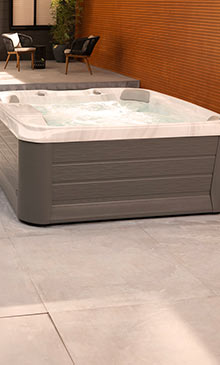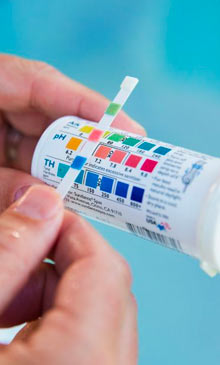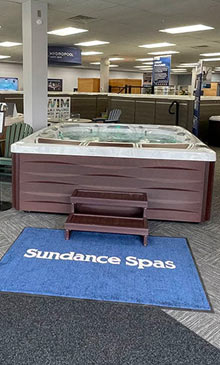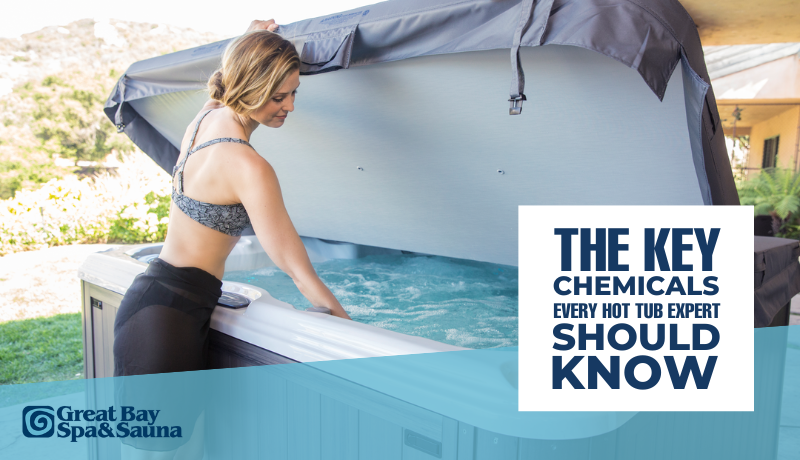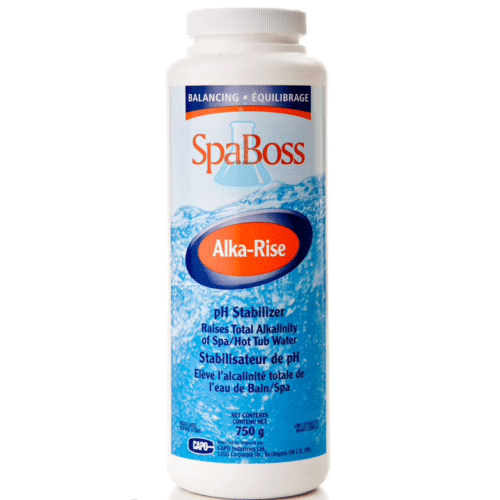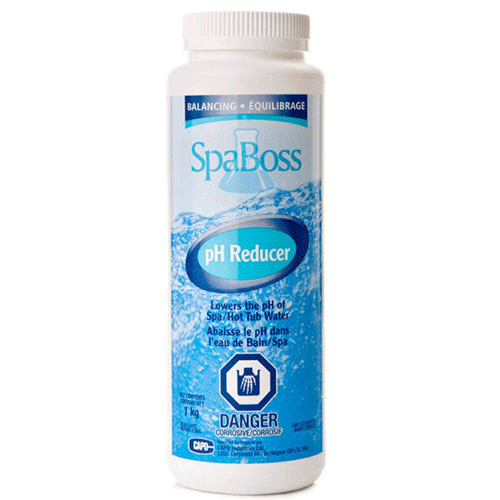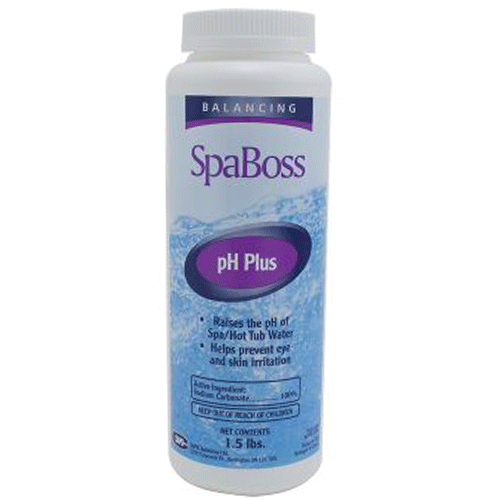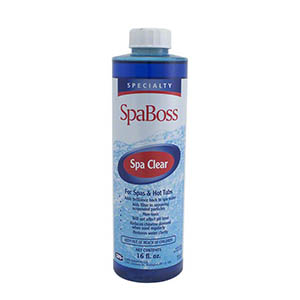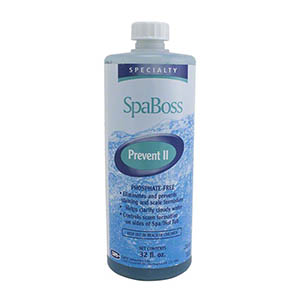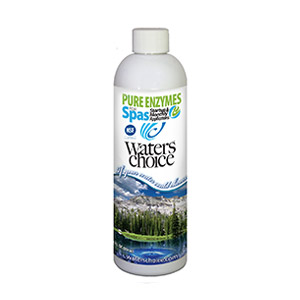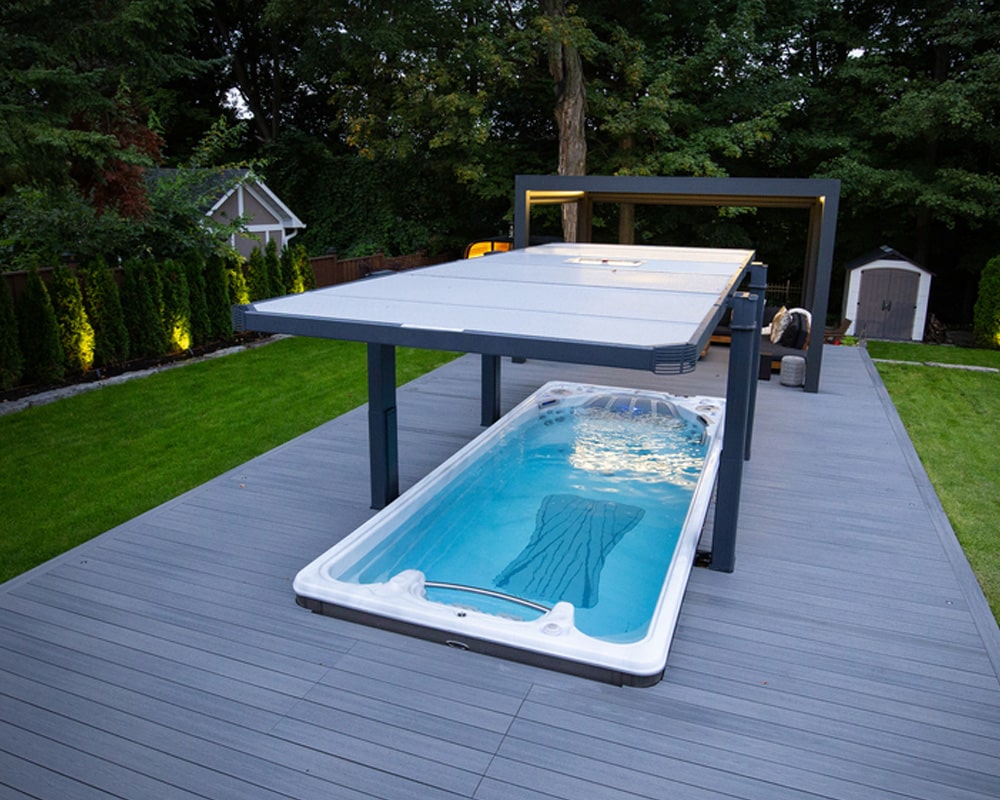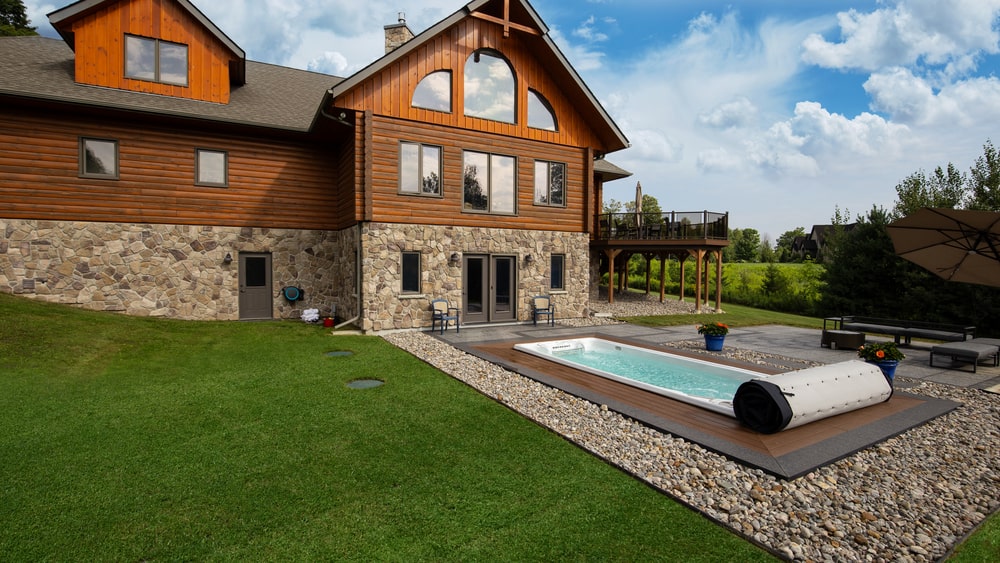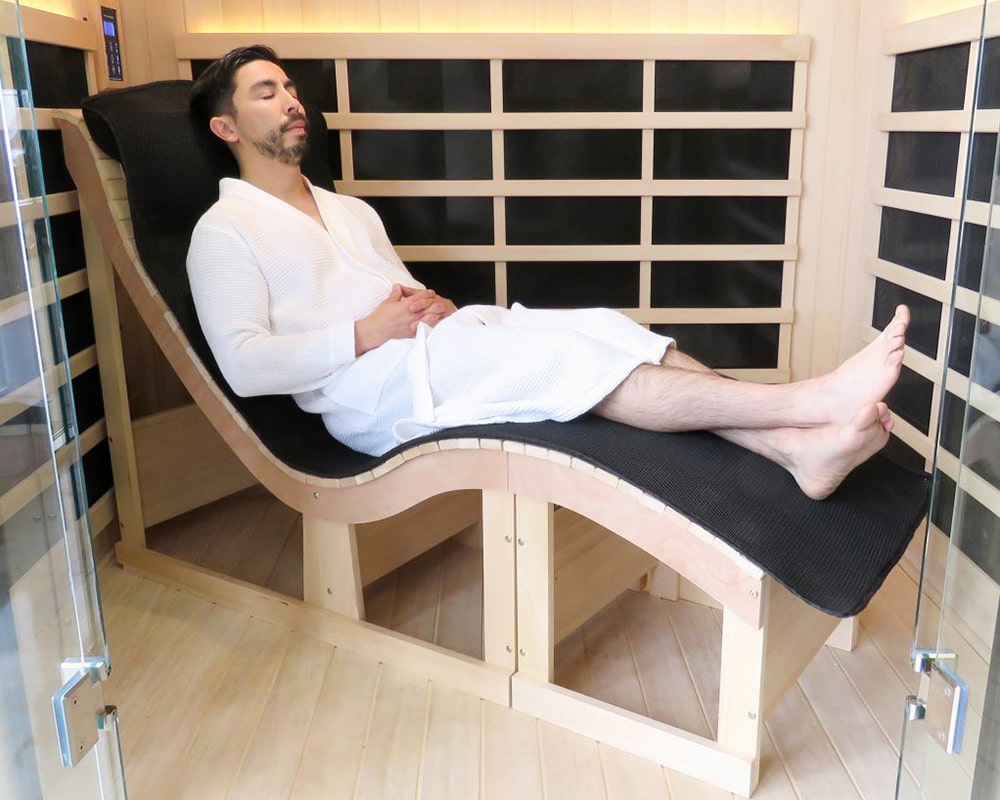If you want to keep your hot tub water balanced and avoid major problems like algae, bacteria, and biofilm build-up, you’ll need to have these hot tub chemicals on hand:
- Hot Tub Sanitizer, like chlorine or bromine
- Hot Tub Shock
- Alkalinity Increaser
- pH increaser
- pH decreaser
- Calcium Hardness Increaser
- Line Flush Cleaner
- Water Clarifier, Metal Sequestrant, Filter Cleaner
Before you add anything to your hot tub, you’ll need to test your water. You’ll want a good supply of test strips. Or for more accurate results, you can use a liquid test kit. You can also take a water sample to your local pool and spa store if you want to test your water source for metals or other minerals. Now after you have your baseline readings, you can start adding your chemicals.
Here are the right hot tub chemical levels:
Hot Tub Sanitizer
First, you’ll need to decide which type of sanitizer you want to use: chlorine, bromine, biguanide, or a mineral system. Each one has its pros and cons. But the biggest debate is whether to use chlorine or bromine.
- Chlorine: Many outdoor hot tub owners use chlorine to sanitize their water. It’s cost-effective, easy to add and manage and it’s an aggressive bacteria and algae killer. The downsides? That chlorine smell. Chlorine kills contaminants by oxidizing. But as this chemical reaction occurs, it gives off waste products called chloramines that cause that smell. If you can smell chlorine, it probably means your chlorine has been used up in your water and you need to add more. Remember, the proper chlorine level for a hot tub is 1 to 3 ppm.
- Bromine: Bromine doesn’t produce that chlorine-like smell in your hot tub. It also lasts longer than chlorine and has a lower pH, making it a little easier to keep the water balanced. And many hot tub owners prefer using it because it’s gentler on your skin. But it tends to work more slowly. It’s also unstabilized. That means if you use it in an uncovered, outdoor hot tub, it’ll burn off pretty quickly under the sun. Bromine is best for indoor hot tubs, or hot tubs that aren’t in direct sunlight. The proper bromine level is 3 to 5 ppm.
Hot Tub Shock
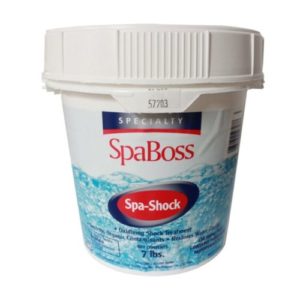
Hot tub shock is a great problem-solver and a must-have for regular hot tub maintenance. It provides a large dose of sanitizer to help ward off any developing water issues.
So if you see algae starting to bloom or you notice cloudy hot tub water, your hot tub shock will help. And a weekly shock treatment is a great way to help refresh your sanitizer levels and prevent issues down the road.
There are two types of shock: chlorine shock and non-chlorine shock. And they both have different applications:
- Chlorine or Bromine Hot Tub: Use either chlorine or non-chlorine shock. If you use a non-chlorine shock, you’ll be able to use your hot tub a lot sooner after you shock it. But chlorine shock is more effective at killing algae or bacteria, so that’s what we recommend.
- Mineral hot tub: We recommend using non-chlorine shock to keep your chlorine levels low.
Alkalinity Increaser, pH Decreaser, pH Increaser
One of the most confusing elements of hot tub water chemistry is pH and total alkalinity. pH measures how acidic your water is. And alkalinity acts as a buffer for pH, neutralizing incoming acid and keeping your pH from drastically changing. These two go hand-and-hand and affect each other whenever they change.
Your total alkalinity levels should be between 80 and 120 ppm. And the proper level for pH is between 7.2 to 7.4. Low pH can cause corrosion in your spa. And high pH can cause itchy, dry skin and burning eyes.
There are a lot of products out there designed to raise or lower both pH and alkalinity all at once. But it’s important to have chemicals on hand that do one thing at a time.
- Alkalinity Increaser: If your water’s total alkalinity dips too low, it can also bring your pH levels down. That’s why it’s important to have an alkalinity increaser on hand.
- pH Decreaser (pH Down): But what if the alkalinity gets too high? Well, there’s actually no product called alkalinity decreaser. To lower your alkalinity, you’ll need to use a pH decreaser. And a pH decreaser obviously lowers pH, too. If your pH is too high, it can reduce your sanitizer’s effectiveness and cause cloudy hot tub water.
- pH Increaser (pH Up): If your pH is too low, it could cause burning eyes and corrode parts in your hot tub. That’s when you’ll need to use a pH increaser.
Calcium Hardness Increaser
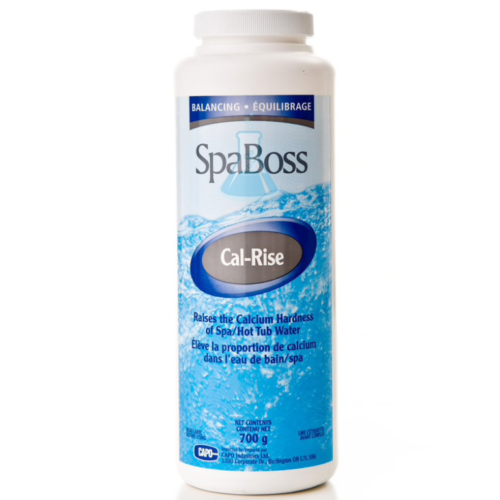
If you live somewhere with hard water, you may get calcium deposits on faucets and showerheads. But you actually want some of that hard water in your hot tub. If your hot tub water is too soft, it can eat away at your hot tub shell, pipes, and other parts. That’s why a calcium hardness increaser is so helpful.
Your calcium hardness levels should be between 175 and 250 ppm. Unfortunately, if your calcium hardness levels are too high, the best solution is to drain your hot tub, scrub it, and start over with fresh, filtered water. That’s why it’s important to add calcium hardness increaser a little at a time.
Line Flush Cleaner
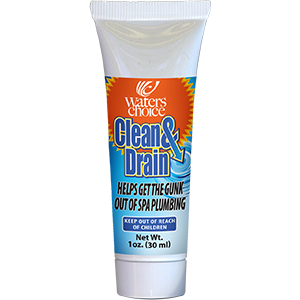
Over time, the plumbing inside your hot tub can begin to accumulate mineral deposits, dirt, and grime. The only way to get rid of that build-up is to use a line flush cleaner and then drain your hot tub.
You’ll want to flush the plumbing and drain your spa every 3-4 months. And if you’ve never done that before, be sure to check out our complete walkthrough on how to drain and clean your hot tub.
Optional Chemicals
- Hot Tub Water Clarifier: A water clarifier helps keep your water sparkling clear. Your hot tub water will look, smell, and feel cleaner when you use a clarifier once a week. Just keep in mind that a water clarifier treats the symptom, not the cause of cloudy water. If you don’t address the root of the problem, like low sanitizer levels or high pH, your water will go back to how it was once the clarifier wears off.
- Metal Sequestrant or Stain and Scale Preventer: If your water source has metals like iron and copper, you may end up with rust-colored or green stains in your hot tub. You can prevent them from occurring by using a metal sequestrant (also called a metal remover). If you have a mineral sanitizer, you’ll have to use metal sequestrant sparingly. Copper is often one of the active ingredients in mineral sanitizers. And too much sequestrant can possibly make the mineral sanitizer less effective.
- Hot Tub Filter Cleaner: You’ll need to remove and clean your filters every week if you have heavy hot tub use. You can use a filter cleaner or phosphate-free dishwashing detergent granules.
- Hot Tub Enzymes: Enzymes help break down organic contaminants like skin cells, body oils, and leaves. They’re not really necessary as long as you keep your sanitizer level balanced, and you drain, clean, and refill your hot tub every quarter.
How To Add Chemicals To Hot Tub Water
Adding the right chemicals in the right order can prevent cloudy water, slimy surfaces, and nasty hot tub smells. And if it’s the first time you’re starting up your hot tub, it’s extra important to add them in the correct sequence. Luckily, all the chemicals you need to start up your hot tub are the same ones we mentioned before that you need to maintain your spa throughout the year.
Here is the step-by-step guide on how to add chemicals:
Before you start adding any chemicals to your spa, you’ll want to know how many gallons your hot tub holds. This will help you add the correct amount of chemicals to your hot tub. You can find your hot tub’s volume or water capacity in your owner’s manual or with a quick Google search.
Here’s how you’ll be adding chemicals to your water:
- Add chemicals directly to your hot tub water. Measure out your chemicals, then add them one at a time to the surface of your hot tub water.
- Wait at least 20 minutes before adding the next chemical. Keep your jets running and your air valves off to help your chemicals evenly and quickly disperse. You’ll want to make sure each chemical is completely dissolved before adding the next one.
- Keep your cover off. You’ll want your hot tub cover removed so chemicals like chlorine can “off-gas.”
- Be safe. Use gloves, goggles, and a mask when handling chemicals. And keep your chemicals separate before adding them to your tub. Mixing chemicals outside of your water can be dangerous and less effective.
In What Order Should You Add Hot Tub Chemicals?

Before adding chemicals, test your water. If this is your very first time filling up your hot tub, you may want to use a more comprehensive test kit to measure calcium hardness or metals like iron and copper.
Tip: Filling up your hot tub with a hose filter can help remove impurities like metals and calcium before they get into your spa.
Next, heat up your spa until the water temperature reaches 80 degrees Fahrenheit or 30 degrees celsius. The hot water will disperse your chemicals more effectively. And run your jets, turn off air valves and keep your cover off of your hot tub.
Finally, it’s time to add your chemicals one at a time, waiting at least 20 minutes between each chemical before retesting. Here’s the step-by-step sequence we recommend for adding chemicals to your hot tub:
1. Add metal sequestrant or stain preventer if necessary
If you need to add this to your water, do so before adding any other chemicals. This neutralizes metals in the water before they can stain your hot tub or harm your equipment.
2. Adjust alkalinity and pH
Your pH helps your sanitizer work more effectively. And Alkalinity helps prevent fluctuations in pH, so it’s important to adjust this level first. Alkalinity and pH go hand-in-hand, so adjusting one can affect the other. That’s why it’s important to add your chemicals one at a time, wait for them to dissolve, then retest your water. And remember, you can always add more, so don’t overdo it. Start with a few tablespoons if your levels are only a bit off.
- Both pH and alkalinity are low: Add alkalinity increaser first. Then test the pH again to see if it needs a pH increaser.
- Low pH: Add a pH increaser. If your pH is too high, add a pH decreaser.
- Low alkalinity: Add an alkalinity increaser.
- Either pH or alkalinity are high: Use pH decreaser to drop them back to the right level.
And after adding each chemical, let them circulate for at least 20 minutes, then retest your water.
3. Adjust Sanitizer levels
Now’s the time to add your chlorine granules or liquid bromine directly to the water. You can also use bromine tablets in a floating dispenser system. As always, start with a smaller amount of sanitizer, test your water, and add more if necessary.
Bromine does not dissolve as quickly as chlorine, so you’ll need to wait a bit longer to retest these levels. And if you’re using bromine tablets in a floater, this can take several days to disperse in your water before you get a proper reading.
If you’re using chlorine to sanitize your hot tub, we recommend using dichlor granules over trichlor tablets. It’s easier to control your dosing with granules compared to tablets. And trichlor can damage your hot tub’s acrylic shell.
4. Adjust Calcium Hardness Levels
These levels do more damage in the long run, like eroding parts in your hot tub parts, so you can wait until your water is sanitized and balanced before adjusting your calcium hardness. Your calcium hardness levels should be between 200 and 400 ppm.
If you need to raise your levels, add a calcium hardness increaser. If your calcium hardness levels are too high, the best solution is to drain your hot tub, scrub it, and start over with fresh, filtered water.
Frequently Asked Questions About Hot Tub Chemicals

Looking for more help adding chemicals to your hot tub? Here are some common questions and answers.
Do I Need to Add Shock after Filling My Hot Tub?
You actually don’t need to add any spa shock right at this stage. Shock helps kill contaminants and remove compounds that build up over time, like chloramines or bromamines. Because your hot tub is full of fresh water, and you don’t have any build-up of contaminants, you don’t need to add shock right away.
You can add a non-chlorine shock once a week. In addition, you can also add shock after heavy use, such as a party. This will help refresh your sanitizer levels.
Can You Use a Hot Tub Without Chemicals?
It’s not safe to soak in a hot tub without chemicals. That’s like getting into a bathtub after someone else has used it! A hot tub without chemicals is the perfect breeding environment for bacteria, algae, and contaminants. Just like a swimming pool, you’ll need to keep your spa water sanitized and balanced. If you’re the very first person to get into a freshly filled hot tub, you might be okay. But that water will get very nasty very quickly.
How Soon Can You Use a Hot Tub After Adding Chemicals?
You’ll want to wait until your chemicals completely dissolve and your water levels are adjusted correctly before using your hot tub. This means waiting at least 20 minutes after adding chemicals before soaking in your hot tub. And if you’ve just added chlorine shock, you’ll need to wait even longer.
How Often Should You Change the Water in Your Hot Tub?
You should drain and refill your hot tub every 3 to 4 months. This is the chance to remove biofilm and build-up that gets stuck in your plumbing and can contaminate your water. Use a line flush cleaner and then drain, clean and refill your hot tub with fresh water.
Conclusion
Hot tub water care may seem overwhelming, but it can actually be quite simple if you have a consistent maintenance routine in place. While that does include testing the water regularly, if you’re testing/adjusting the water more than once a week or are feeling uncertain about the results, bring a sample to Great Bay Spa & Sauna. Our team offers free water testing and will provide expert advice to help keep your hot tub in top shape. Don’t let water care stress you out, trust the professionals at Great Bay Spa & Sauna to assist you every step of the way.
